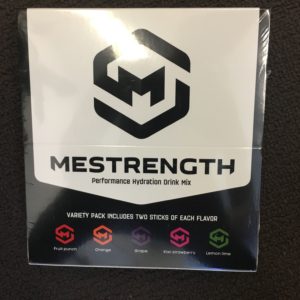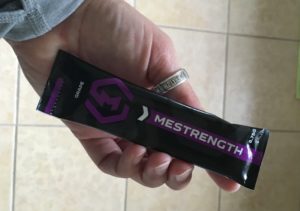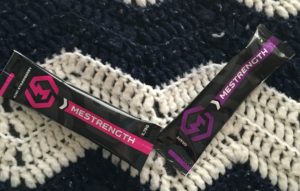Disclosure: I received free samples of MeStrength because I am a BibRave Pro. Learn more about becoming a BibRave Pro, and check out BibRave.com to review find and write race reviews. It’s a great way to help race directors see what is working and what needs improvement, and to help other runners find out what a race is really like.
Psst! Want a discount on MeStrength? Through September 30, 2016 you can get MeStrength for 25% off by using the code bibchat716 at the MeStrength online shop.Click To Tweet
Runners today are lucky to live in a world with unlimited hydration options. Do you like flavored or unflavored? Liquid, powder, tablet? Single serve or bulk? Sugar, monkfruit, stevia, sugar alcohols? Carbs? Caffeine? Electrolytes alone, or in combination with fuel/protein/something else? Pre-workout or post-workout? Strawberry, grape, lemon-lime…we could be here for awhile. Anyway, you get the point.
MeStrength is hydration with creatine. “Creatine?” I can hear you asking. “Isn’t that something that 1970s musclehead lifters use?” Au contraire, and that is the focus of this review.
(If you want to read about all the details that make MeStrength a fine product–such as the attention to detail in the manufacturing process, or how the electrolytes are isotonic which is the same as they exist naturally in your body–you can head to the MeStrength website. There are too many specifics to cover in my one little review.)
What is Creatine and Why Should You Care?
Let’s start at square one. “Creatine is a nitrogenous substance, derived from arginine, glycine, and methionine, found in muscle tissue.” Your body makes it in the liver, pancreas, and kidneys. It is part of creatine kinase, which is an isoenzyme found in muscle and brain tissue that catalyzes the formation of ATP (remember that from high school biology?). Creatine is present in HIGHER amounts after muscle injury, which should make it very interesting to anyone involved in sports training, since part of what you do when you work out (and race) is break down muscle tissue (that’s injury).
Creatine is considered a non-essential nutrient. Precision Nutrition defines a non-essential nutrient as “food-based nutrients that either the body can make itself, assuming adequate nutritional intake, or nutrients that aren’t needed for normal physiological functioning.” Creatine falls into this category, along with glutamine, the other non-essential amino acids, caffeine, and green tea extract.
Creatine is also one of the best-studied potential supplements. According to the Precision Nutrition textbook (see Resources section), there are over 500 published studies on creatine supplementation. When I did a search in PubMed specific to creatine and exercise, I found 414 studies (and remember, PubMed doesn’t index every published study). Oh, and in case you have Olympic dreams, creatine isn’t on the World Anti-Doping Agency banned substances list.

Let Me Drop Some Science On You: ATP and Energy In the Body
ATP is adenosine triphosphate; basically that’s adenosine (A) with three phosphate molecules (P) attached. One of the ways the body makes energy is to break the bonds that hold the A to one of the P, creating ADP (adenosine with two phophates) and P (just the phosphate, all by itself); the body then regenerates the ATP, basically recycling it. This all happens through the ATP-PCr system. Creatine kinase breaks up phosphoecreatine (PCr) into two parts, creatine (Cr) and phosphate (the same P we’ve been discussing), by breaking the bond that holds them together. That creates both energy from breaking the bond, and extra P that can be used to make more ATP (by combining with
The body stores about 80-100 grams of ATP, which is enough to fuel maximal exercise–think crazy hard sprint–for a few seconds. When you engage in intense exercise, the body’s natural supply of PCR only lasts about ten seconds. Once that system is maxed out, you MUST slow down–your body can’t carry you faster.
Creatine Benefit #1: Improved Muscular Performance
If you train hard, doing the type of high-intensity exercise that is dependent on the ATP-PCr system (hill repeats? strength training?wind sprints?), and would like to add lean muscle mass, creatine supplementation can help you. (In contrast, if you do low-volume or infrequent exercise, or always run in the very comfortable jog-zone, creatine isn’t likely to offer you many benefits.)
Supplementing with creatine improves your performance in a very specific way: “By increasing the intramuscular creatine pool, more creatine (and PCr) will be available for high intensity, short-bury muscle contractions. Research has shown that higher concentrations of intramuscular creatine are linked with improved force during maximal contraction, and improved staying power with high intensity exercise.” (74) In other words, adding creatine helps your hard training by letting your body continue to recycle the ATP, and that gives you strength and longer endurance (for the high-intensity periods like sprints or lifts you can improve your staying power past the usual ten seconds).
Creatine Benefit #2: Improved Muscle Recovery
If you’ve read anything about training or worked with a trainer, you’ve probably heard about the SAID principle which states that the body responds to training with Stragetic Adaptation to Imposed Demands. In other words, if you repeat an exercise over time your body will get better and more efficient at doing that exercise. (This is also the reason why you eventually burn fewer calories doing the same workout, and why trainer Tony Horton’s programs all vary exercises instead of sticking with the same program over and over; he calls it “muscle confusion,” but let’s be real: your muscle isn’t confused, it’s just getting better at performing something it has rehearsed many times.)
The body’s responses to training include increases in stored ATP and increases in stored PCr. The more you engage in high intensity exercise, the better your body adapts to using the ATP-PCr cycle to fuel the system, and the faster it can do it. This has an additional benefit: “Increasing the rate of creatine phosphate resynthesis during intense exercise appears to lower blood lactate accumulation and ammonia levels, both byproducts that inhibit peak performance output,” according to research cited by Elliott Reimers (see Resources below).
Translated into everyday language, that means two things. First, in doing high intensity exercise, your body recovers faster so you can spend less time resting between intervals. Second, your final recovery may also be easier (as your body will have less muscular waste product–lactate and ammonia if you supplement with creatine). There is at least one study that shows creatine supplementation can help with recovery following injury.
MeStrength
Packaging. MeStrength comes in individual “stick” style packets, making it portable and easy to use while on the run (or at the gym, if that’s your schtick–see, I’m funny!). The instructions say to mix with 20 oz of water, though if you happen to have a water bottle that only holds 16 oz (as I did during one test), it just ends up with a slightly stronger flavor, and you can always add more water later. As with any supplement (and pretty much any other consumable product I can think of, from canned tomatoes to toilet paper), buying the larger package is more economical.
Usage. While I initially thought of MeStrength as a pre-workout because that provides the benefit of pre-hydration and available extra creatine within the body, it also works well as an in-workout hydration product. Given the study showing creatine can aid recovery, and I don’t know anyone who is properly 100% hydrated following a hard workout, there is also evidence it would make a good post-workout/recovery beverage.
Ingredients. Setting aside creatine, what’s in it? MeStrength contains five electrolytes: calcium, phosphorus, magnesium, sodium, and potassium. Personally, I find this superior to the hydration products that rely exclusively on sodium and potassium. I’m a sweaty girl, and I’m sure I lose ALL the electrolytes during an intense workout. It’s definitely better than consuming only potassium (which can cause cardiac issues in some individuals) or just sodium (which makes some of us feel water-logged but still thirsty).
The other ingredients are citric acid, natural flavor, vegetable and fruit juice for color only, and stevia (for a touch of sweetness).
- Citric acid exists in nature in fruits and vegetables, and is often used as a preservative. It also occurs in the citric acid cycle, part of the metabolic processes in humans (and other living things).
- Natural flavor has a very specific meaning in the administrative code relevant to the FDA: “[natural flavor] means the essential oil, oleoresin, essence or extractive, protein hydrolysate, distillate, or any product of roasting, heating or enzymolysis, which contains the flavoring constituents derived from a spice, fruit or fruit juice, vegetable or vegetable juice, edible yeast, herb, bark, bud, root, leaf or similar plant material, meat, seafood, poultry, eggs, dairy products, or fermentation products thereof, whose significant function in food is flavoring rather than nutritional.” Code of Federal Regulations (CFR), Title 21, Section 501.22 MeStrength is a vegan product, so the natural flavor does not come from meal, etc. You can safely ignore all the fear-mongers who claim the term natural flavor is a way to hide mystery ingredients in food.
- Vegetable and fruit juices for color only means the small amount of juices present do not add nutrients (or calories) to the product.
- Stevia is a sweetener/sugar-substitute that comes from the plant Stevia Rebaudiana. It has a slightly bitter aftertaste so it isn’t usually used as the sole sweetener, but I didn’t notice any bitter aftertaste in MeStrength.
Taste & Opinions. Overall, I liked the taste of MeStrength, with my favorite flavor being fruit punch. (That’s almost always my favorite flavor in supplements. Something about how much I loved Hawaiian Punch as a kid.) It isn’t super sweet like, say, full-strength Gatorade or Powerade. As I mentioned above, there isn’t a bitter aftertaste. I’m willing to bet those who complain they don’t like the new Nuun formulations due to the stevia won’t even notice it in this product. I also like that this product separates hydration (electrolytes) and supplementation from fuel. I tend to need hydration at a more rapid rate than fuel, and my stomach cramps if I rely on a two-in-one product. This way I can use MeStrength by itself, add it to a fuel product, or consume separate fuel (like actual food!)

Resources
The Essentials of Sport and Exercise Nutrition, Certification Manual, second edition. John Berardi, PhD; Ryan ANdrews, MA, MS, RD. (All of the material in quotation marks above is from this textbook, numbers indicate page numbers.)
“All About Creatine.” Ryan Andrews
“Body Fuel: Creatine Myths” John Berardi, PhD
“Does Creatine Impact Recovery & Delayed Onset Muscle Soreness?” Elliott Reimers
My search on PubMed returned 414 results on July 12, 2016. (Search terms: “creatine supplementation and exercise performance”)